
-
- Remembrance
-
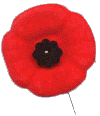 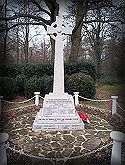 
| |
- Here we have some more details
of some of Normandy's dead of two World Wars - those brave men who endured
hardness and faced death with defiance and died in defence of all that
they held most dear.
Many of the names on Normandy's
War Memorial are well known and remembered simply because the family name
remains a part of this village but a few names are not so well known today.
- "We are hoping to add more to this
page from time to time but if you can help please let us know."
-
- The Great War
- Frederick
James Trussler
Private PO/13907 Royal Marine Light Infantry
HMS "Good Hope"
- Born in Worplesdon in 1882, Frederick was the son of Thomas and Annie
Trussler of Pinewood Road. He was a member of the Royal Marine Light Infantry
aboard H.M.S. "Good Hope" in November 1914 when the Ship
was sunk along with HMS "Monmouth" by the German armoured cruisers
Scharnhorst and Gneisenau under Admiral Graf Maximilian von Spee with the
loss of her entire complement of 900 hands in the Battle of Coronel, on
Sunday 1st November 1914, off the Chilean coast near the city of Coronel.
The Royal Navy squadron was commanded by Rear-Admiral Sir Christopher Cradock.
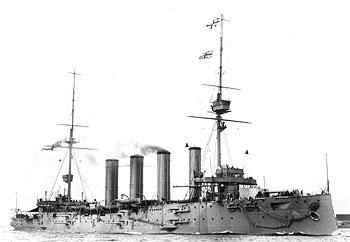
|
- HMS Good Hope
- Completed: 1901
Tons full load 14,100 tons
Length: 529.5 ft (161.4 m)
Beam: 71 ft (22 m)
Draught: 28 ft (8.5 m)
Complement: 900
Fate: Sunk at the battle of Coronel 1st November 1914
|
(CWGC) Certificate 2872229
Wikipedia links
HMS Good Hope
Battle
of Coronel

- Wilfred
James Taylor
- Royal Navy (Boy 1st Class)
- Wilfred James Taylor was the son of Luke and
Amelia Taylor of Basingstoke, Hants and the grandson of James and Mary
Taylor of Chester Cottage, Guildford Road, Normandy Surrey.
Wilfred was serving with HMS Bulwark
in November 1914, from the beginning of the First World War in August 1914,
Bulwark and the 5th Battle Squadron, assigned to the Channel Fleet and based
at Portland upon the outbreak of war, carried out numerous patrols in the
English Channel under the command of Captain Guy Sclater.
On 14th November 1914, the 5th Battle Squadron
transferred to Sheerness to guard against a possible German invasion of
England.
A powerful internal explosion ripped Bulwark
apart at 7:50am on Thursday 26th November 1914 while she was moored in Kethole
Reach, 4 miles west of Sheerness in the estuary of the River Medway. Wilfred
was one of those lost on that day at the age of only 17 years, out of Bulwark's
complement of 750, no officers and only 14 sailors survived, two of whom
subsequently died of their injuries in hospital. Most of the survivors were
seriously injured.
A naval court of enquiry into the causes of
the explosion held on Saturday 28th November 1914 established that it had
been the practice to store ammunition for Bulwark's 6-inch guns in cross-passageways
connecting her total of 11 magazines. It suggested that, contrary to regulations,
275 six-inch shells had been placed close together, most touching each other,
and some touching the walls of the magazine, on the morning of the explosion.
The most likely cause of the disaster appears
to have been overheating of cordite charges stored alongside a boiler room
bulkhead, and this was the explanation accepted by the court of enquiry.
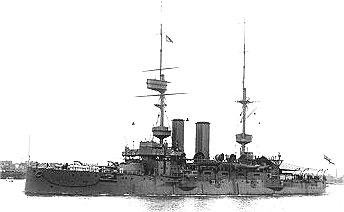
|
- HMS Bulwark
- Completed: March 1902
Tons full load 15,366
Length: 431 ft 9 in (131.60 m)
Beam: 75 ft (23 m)
Draught: 27 ft 3 in (8.31 m)
Complement: 750; (766 as flagship)
Fate: Destroyed by internal explosion, 26 November 1914
|
(CWGC) Certificate 2872166
Wikipedia links
HMS
Bulwark
5th Battle Squadron

- Private
L/8544 Albert Goddard,
- 1st Battalion "The
Queen's (Royal West Surrey Regiment)"
| Albert Goddard was killed in action (Belgian and
Flanders) the 31st October 1914 during the First Battle of Ypres, when
a small British Expeditionary force succeeded in securing the town before
the onset of winter. His name is inscribed on a panel of the Ypres (Menin
Gate) Memorial which bears the name of more than 54,000 officers and
men whose graves are not known. The Memorial designed by Sir Reginald Blomfield
with sculpture by Sir William Reid-Dick, was unveiled by Lord Plumer in
July 1927. |
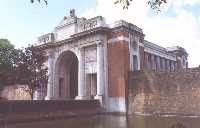
The Menin Gate |
| It is normal for the "Debt of Honour Register"
of the Commonwealth War Graves Commission and the Commemorative Scroll
to indicate "next of kin" and place of residence but for this
soldier the information is sparse stating only that he was born in Ash,
Surrey; enlisted in Guildford Surrey and lived in Ash, Surrey.
Research of the 1901 Census shows that at Pirbright
Road, Ash, Normandy, Surrey, .Ann Goddard is head of the household, a widow
aged 45; Albert her son aged 10, born in Normandy, Surrey and thus being
born in about 1891; Ernest her son aged 5, Edith Tibble her daughter aged
23 and Herbert Tibble grandson aged 4. |
| In the Electoral Registers for Normandy (1918
- 1939), held at the Surrey History Centre, Woking, a family, named Goddard
were resident at 1, Laurel Cottages, Upper Pinewood Road between 1918 and
the early 1930s. The forenames of the electors (21 years of age and over)
were Ann, Ernest and William, the two former persons (Ann and Ernest),
corresponding with the names of those in the 1901 Census. Ernest (5 years
of age in 1901) would have been eligible to vote in 1918. Private Albert
Goddard (if he was the same Albert as in the 1901 Census), would have been
about 23 years of age when killed in action at Ypres,.
Whilst not conclusive, it is most probable
that the next of kin of Private. L/8544 Albert Goddard, killed in action
the 31st October 1914, was his mother, Ann Goddard of 1, Laurel Cottages,
Upper Pinewood Road, Normandy Ash. At that time Normandy was a Ward of
Ash Parish. It is also reasonable to presume that Albert had enlisted prior
to the outbreak of the Great War and therefore, had no place of residence
other than that of the British Army. |
-
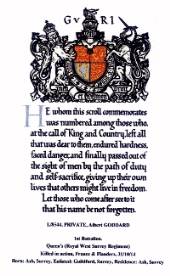
- Debt of Honour Scroll
Click on photo to see an enlargement
|

- Lieutenant
Philip Brydges Henriques
King's Royal Rifle Corps
- Philip Brydges Henriques, born in 1895, was the only son and child of Sir
Philip and Lady Henriques of Normandy, Surrey. Philip was a Second Lieutenant
in the 8th Bn Kings Royal Rifle Corps and died age 20 years on the 24th
July 1915 from his injuries received in the Second Battle of Ypres (April
22nd to May 15th, 1915). He is remembered with honour at Lijssenthoek Military
Cemetery and with a stained glass window in St. Marks Church, Wyke, Normandy.
Also, his name is etched on the War memorial here in Normandy. Philip's
name is also on a memorial at All Saints Church, Eastbourne.
Also see  Henriques
Memorial Window at St. Marks Church, Wyke Henriques
Memorial Window at St. Marks Church, Wyke
-
(CWGC) Certificate 144688
-
- Wikipedia links
Second Battle of Ypres
King's Royal Rifle Corps

- Private 23182
Thomas Martin Blaber
- 138th Company Machine Gun Corps (Infantry)
Thomas Martin Blaber age 26 was killed in action
on Sunday the 8th October 1916 during very fierce fighting near the two
villages of Warlencourt and Eaucourt-L'Abbaye in the Pas de Calais and
is buried in Warlencourt British Cemetery located near Bapaume. There is,
however, a minor discrepancy between his rank on the War Memorial (Lance
Corporal) and that of the Record of Commemoration by the Commonwealth War
Graves Commission (Private). |
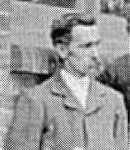
- James Blaber c.1900
- Head teacher of Wyke
- Father of
- Thomas Martin Blaber
|
Thomas Martin Blaber was the only son of James
and Dinah Blaber of Seacombe, Eastwood Boulevard, Westcliffe-on-Sea Essex
and was born in 1891 at Jevington, Sussex closely followed by his two sisters
Winnie (1893) and Florrie (1895). James Blaber, his father, commenced duties
as Head teacher of Wyke School on 11 April 1899 retiring in 1915 during
which time Dinah, his wife, also taught at the school with three other
assistant teachers, the Misses Marion Gaffney, Alice Hogsflesh and Mabel
Weston. Mr and Mrs Blaber's two daughters, Florrie and Winnie, won a three-year
scholarship to the Guildford Training College. Winnie returned to Wyke
in 1910 to teach as a Certificated Teacher until 1912. |
| The Aldershot News of the 3rd of November 1916
reported the death of Private Thomas Blaber and added that before he enlisted
at the beginning of the War, he was a teacher at Berkhamsted and at the
Ash Street School. The following week the paper gave an account of his
death stating "Blaber had displayed calm heroic courage gathering
survivors under extreme heavy fire. He got together a number of men and
then saw a friend. He was shot whilst shaking hands".
Whilst at Wyke School, Mr James Blaber had
two houses built for himself, namely Ringwood (now Rosewood) and The Nook
on the Pirbright Road (then known as Normandy Park Road), residing in each
as they were built until his retirement from the school in 1915. Neither
Mr Blaber nor his wife Dinah enjoyed good health in their latter years
at the school and in retirement probably moved to Westcliffe-on-Sea, Essex
on health grounds. He retained ownership of The Nook until 1921 and Ringwood
until 1929. |
-

| Fred and
Henry Collyer
Royal Navy
A Double Bereavement
Mrs F Collyer of Hillcroft, Pirbright Road, Normandy had suffered a second
bereavement by the war, having received official information that her only
surviving son, Henry, a cooks mate on a destroyer, had lost his life on
30th June through the vessel having struck a mine in the North Sea. Henry
Collyer who was 23 years of age and an old boy at King Edward School, Witley.
He had two or three narrow escapes from death previously. He joined the
Navy in March 1913 and had gained his stripe for eleven years good conduct.
After seven months service he won a prize of ten shillings - a silver medal
and certificate, for the excellence of his exhibit at the Naval Cookery
Exhibition in 1913.
Deceased served first on the Indomitable, and was in the bombardment
of the Dardenelles in 1914. In January of the following year he was in
action in the North Sea. Subsequently he was transferred to a minesweeper
which was torpedoed the day before the Jutland battle, and was in the water
an hour and a half before being rescued. His next boat struck a mine in
the Atlantic in March last, and was sunk, and again he was rescued only
to lose his life three months later, Henry Collyer was serving on HMS Cheerful
when it was sunk by a mine in the North Sea on June 30th 1917. His only
brother, Fred Collyer, a first class stoker on the Queen Mary, lost his
life in the Battle of Jutland. (Report from the
Surrey Advertiser, July 1917)
Henry Collyer was serving
as a cook on HMS Cheerful, a Mermaid class destroyer which served
with the Royal Navy. She was launched on the 14th of July 1897 and was
mined off the Shetland Islands on June 30th 1917, mine laid by SM UC-33
commanded by Martin Schelle.
Henry Collyer was lost with the ship.
- HMS Cheerful
- Completed: July 1897
Tons normal 370
Tons full load 430
Length: 210 ft (64 m)
Beam: 23 ft (7 m)
Draught: 13 ft (4 m)
Complement: 50 to 60
Fate: Mined on 30 June 1917
|
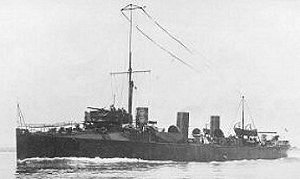 |
Fred Collyer
was serving as a first class stoker on HMS Queen Mary, a
battlecruiser of the British Royal Navy. She was similar to the Lion class,
though she differed in details from her half-sisters.
At the Battle of Jutland in May 1916, she was hit twice by the German
battlecruiser Derfflinger and exploded shortly afterwards.
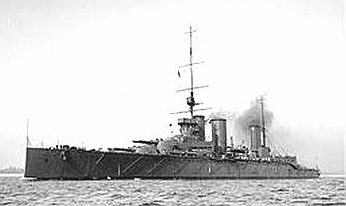 |
- HMS Queen Mary
- Completed: August 1913
Tons normal 26,770
Tons full load 31,650
Length: 703.5 ft (214.4 m)
Beam: 89 ft (27 m)
Draught: 28 ft (8.5 m)
Complement: 997 to 1,275
Fate: Exploded and sunk at Jutland on 31 May 1916
|
|
-

- Lieutenant
R. C. Stedman
- East Surrey Regiment
Raymond Cecil Stedman was the youngest son of Arthur (wheelwright),
and Maria Stedman of Glenmore (now renamed Denelands), Normandy, Surrey
born c. 1891 and baptised at St Mark's Church, Wyke by L White Atkins (Curate)
on March 25th 1891.
Little is known of his early years other than he spent about eight years
in the Territorial Army and went to India with the 1st/5th Queens Regiment
in October 1914, returning as a time expired man in June 1916. Following
his return to home he was again for a time serving in the 2nd/5th Queens
Regiment and was chosen for a commission. His period of training was spent
in Ireland. In January 1917 he was commissioned to Second Lieutenant serving
with the East Surrey Regiment.
He was injured in action and died at age 26 years on the 20th May 1918
at the 54th Casualty Clearing Station near the town of Aire, France, located
within 8 miles of the German lines. He is buried in the Aire Communal Cemetery.
His father Arthur died 1920 and was buried at St Mark's Wyke the 4th
January 1921 age 74 years and his mother Maria preceded Arthur, dying in
1905 at age 58 years and was buried at St Mark's Wyke the 22nd of April.
CWGC Certificate 467455
- Wikipedia links
- East Surrey Regiment
|

- Lance Corporal
Roy Alfred Roberts
- Royal West Surrey Regiment
| Lance Cpl. Roberts, 19 years of age, serving as a Lewis gunner with
"B" Coy, 7th Bn., Royal Sussex Regiment and who had been in the
army two years, was killed on the 26th August 1918 by a shell bursting
close beside him. He is buried at the Dantzig Alley British Cemetery at
Mametz, France with 93 others from his regiment.
For three years he was a member of St Mark's church choir and Sunday
school, and after leaving school was employed in the Army and Navy Stores,
Aldershot, and at one time by Messrs Vicks. His younger brother, Douglas,
of the East Kent Regiment, was in hospital in France, wounded, and his
father, who previously had served in the Army, returned to the forces at
the beginning of the war, and then served in the Remount Dept in Egypt.
Lance Cpl Roberts death was reported in the Surrey Advertiser on Saturday
14th September 1918 |
-
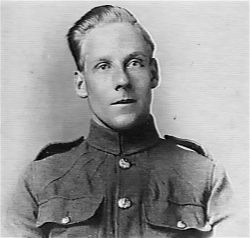
- Roy Alfred Roberts
- about 1917
|
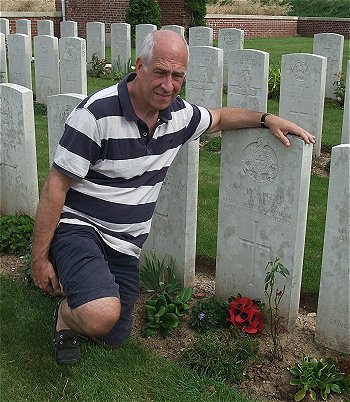
- Mick Roberts at his great uncle's gravestone at Dantzig
Alley British Cemetery, Mametz in
- August 2014
|
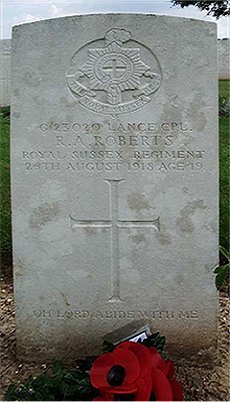
- Gravestone of Roy Alfred Roberts at
- Dantzig Alley British Cemetery, Mametz
|
CWGC Certificate 548246
- Wikipedia links
- Royal Sussex Regiment

- Private
Frank Herbert
- Royal Berks Regiment
Private Frank Herbert, Son of Mr. and Mrs. Herbert, of Vine Cottage,
Normandy, who was age 24 and was serving with 8th Bn., Royal Berkshire
Regiment in the Eastern Somme was killed in action on August 27th 1918.
His commanding officer, in writing to his parents, said that death was
instantaneous, a bullet passing through his forehead. He is buried at the
Bernard Wood British Cemetery at Montauban, France.
Private F. Herbert death was reported in the Surrey Advertiser on Saturday
26th October 1918
CWGC Certificate 245891
- Wikipedia links
- Second Battle of the Somme (1918)
- Royal Berkshire Regiment
|

- Rifleman
Francis John Hobbs
- Rifle Brigade
Francis John (Frank) Hobbs was born July 1st 1899 in Long Sutton,
Hampshire. He was the seventh of eight children of George and Mary Hobbs,
nee Cook, both descended from Hampshire families as far back as has been
traced. George was a shepherd and used to drive flocks of sheep along the
Hogs Back to Guildford market.
Some time between 1899 and 1908 the family moved to Normandy, 2 Junction
Cottages, Pound Farm Lane, where the last child, Dorothy was born in 1908.
George worked at Henley Park Farm.
Frank attended Wyke school with the Roberts brothers and others whose
names are on the memorial. After leaving school he worked as an under
gardener at Clandon Park.
Frank was conscripted in 1917 to the 1st Battalion, the Rifle Brigade,
at the Winchester depot. His elder brother Fred was already serving, and
was subsequently invalided by an injury sustained at Salonika.
Frank died 1st September 1918 during the "Advance to Victory"
campaign, between Arras and Cambrai. |
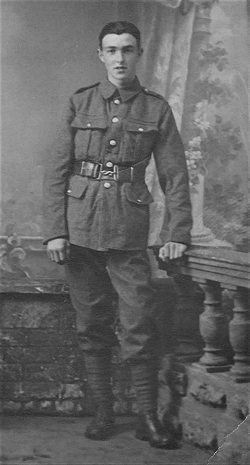
- Francis John (Frank) Hobbs
- Those that remember Joan Dyson, Frank's niece,
will note the strong family resemblance
|
| According to one of his comrades who visited the family after the war
Frank was killed by a high explosive shell and no remains were found.
His name is on the memorial at Vis-en-Artois, close to where he died.
CWGC Certificate 1743721
- Wikipedia links
- Rifle Brigade
- Vis-en-Artois Memorial
- Hundred Days Offensive (Advance to Victory)
Information by Paul Dyson, John Pettitt and John Boylett
|

- Second World War
- RAF 551566
Dennis (Denis) Victor Woods
15 Squadron - Bomber Command
- Dennis Woods was born
in 1921, the only son of Harry and Amy Woods of Festubert, 2 Willey Green
Cottages, Normandy. He attended Wyke School, the Sunday school at the Congregational
Chapel, Willey Green in the late 1920's and in the 1930s was in the Normandy
Scout Group. At the outbreak of the Second World War he joined the Royal
Air Force (RAF 551566) and soon was promoted to Leading Aircraftman with
15 Squadron - Bomber Command, serving as a gunner in Bristol Blenheims.
|
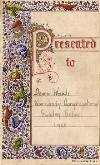 Presented
to Dennis Woods in 1928 by the Congregational Chapel Sunday School for
attendance Presented
to Dennis Woods in 1928 by the Congregational Chapel Sunday School for
attendance
- Click on photo to see an enlargement
|
| From 14th April 1940, the squadron was based at Alconbury. On the 11th
- 12th May 1940 the squadron was airborne on its second mission, briefed
to destroy the strategic bridges over the Albert Kanaal at Maastricht.
The squadron took a severe knock; seven planes were lost with 14 personnel
killed and 4 interned as Prisoners of War. Only six aircraft and crews
returned from the raid and those aircraft that did come back were badly
damaged. Dennis was part of the crew of a Bristol Type 142L, Blenheim Mk.IV
Serial number: P6911, LS(?) with Flying Officer Albert E.Oakley and Sergeant
Douglas J. Avent. Their plane crashed near Munsterbilzen (Limburg), 5 miles
South-South-East of Genk, Belgium. There were no survivors and the cause
of the crash was not established.
Dennis is buried at the Munsterbilzen Communal Cemetery, Belgium.
CWGC Certificate 2258928
Wikipedia links
15 Squadron RAF
Bristol
Blenheim
Albert
Canal |

Francis George
Rees
RAF Sergeant (RAFVR, Service Number 1335744)
Francis (known as Frank) was born 1920 near Farnham, Surrey, the
son of Albert and Florence Rees. The family moved to the Nightingale (Public
House) about 1935, Frank married Kathleen Elizabeth Miles of The Mount,
Dolleys Hill, Normandy at St Peters Church, Ash in June 1942.
Frank joined the RAFVR and served with 78 (Bomber) Squadron, Based at
Breighton, near Bubwith, Yorkshire. Squadron records and Commonwealth War
Graves records show him as a navigator on Halifax bombers.
On the night of 22 March, 1944 he was the navigator on a Halifax Mk III,
code EY-O, s/n LW512 that departed Breighton at 7:07pm for a raid on Frankfurt
am Main. The mission took the aircraft out over the North Sea then inland
to a point south west of Bremen from which the raid flew directly south
towards Frankfurt. It was on the westbound leg from Frankfurt that the aircraft
was intercepted by a German night fighter and shot down near the town of
Mohrweiler, Germany.
Only the rear gunner Sgt. S. A. Waterhouse managed to bail out. He was
interned in a prisoner of war camp, the rest of the crew was buried in the
Rheinberg Cemetery.
Information by Ken Ettie (Frank
& Ken's father were cousins)
(CWGC) Certificate 2032533
Wikipedia links
No.
78 Squadron RAF
Handley
Page Halifax

Clifford Rayward
Royal Navy (Air Mechanic 1st Class)
Clifford, born in 1922 was the son of William Thomas and Winifred Maud Rayward,
the family moved to Normandy in the early war years. Clifford was serving
on the aircraft carrier HMS Dasher as a Air Mechanic in March 1943.
HMS Dasher started out as the merchantman Rio de Janeiro built by Sun
Shipbuilding (Maritime Commission contract (Hull Sun-62)). She was converted
at Tietjen & Lang, transferred to the Royal Navy and finally commissioned
into RN service as HMS Dasher (D37) on 2 July 1942. She participated in
Operation Torch, with her sister HMS Biter, carrying Sea Hurricanes of 804
Naval Air Squadron. After doing some aircraft ferry operations in the Mediterranean,
Dasher sailed to the Clyde in March 1943 and, having had her flight-deck
lengthened by 42 feet, she embarked Fairey Swordfish aircraft. She escorted
one convoy successfully, but shortly after leaving with the second, Dasher
suffered engine trouble and turned back. Shortly after getting to the Firth
of Clyde on 27 March 1943, she suffered a major internal explosion and sank,
Clifford was one of those lost on that day at the age of only 20 years. |
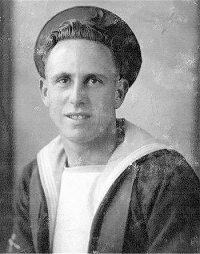
Clifford
Rayward
Royal Navy
(Air Mechanic 1st Class)
|
Various possible causes have been suggested, including one of her aircraft
crashing onto the flight deck and igniting petrol fumes from leaking tanks.
Much of what happened will never be known. Her death toll, 379 out of 528
crewmen, despite rapid response and assistance from ships and rescue craft
from Brodick and Lamlash on the Isle of Arran and from Ardrossan and Greenock
on the Scottish mainland, was amongst the highest in British home waters.
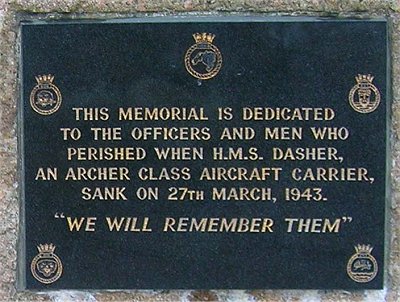
The memorial at Ardrossan seafront
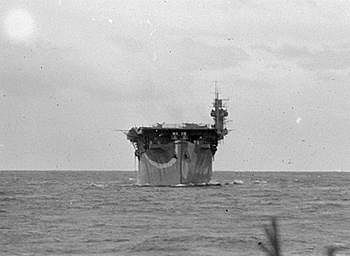 |
- HMS Dasher
- Completed: 1941
Tons full load 8,200 tons
Length: 492.25 ft (150.04 m)
Beam: 66.25 ft (20.19 m)
Draught: 23.25 ft (7.09 m)
Complement: 555
Fate: Sunk by internal explosion 27 March 1943
|
(CWGC) Certificate 2975121
- Wikipedia links
HMS Dasher

- Ernest William
Knox
Sergeant (1350796) 29 Squadron Royal Air Force
Volunteer Reserve
Ernest William Knox, born in 1920 at Kingston, Surrey, was the only son
of Reginald and Rose Knox. He had three sisters: Edith, Kathleen and Margaret;
the family living at "Rosemary", Westwood Lane, Normandy from
1922 until about 1950. All four children were pupils at the local Wanborough
School.
During a storm on the afternoon of Saturday 6th November 1943 a Hunsdon
(Hertfordshire) based twin-engine DH98 Mosquito from RAF 29 Squadron, Mk
X11 (Serial no. HK140) was heavily buffeted and began to break up over the
site of the old lunatic asylum (Brookwood Hospital) in Knaphill, killing
the two aircrew, Flight Sergeant (pilot) Thomas Henry Mullard, aged 20 and
Sergeant (Navigator) Ernest William. Knox, aged 23, both of whom are buried
at Brookwood Military Cemetery.
(CWGC) Certificate 2667334
- Wikipedia links
No. 29 Squadron RAF
de
Havilland Mosquito
Knaphill

- Private
14724608 Roy Hammond
- 4th Battalion, King's Shropshire Light Infantry
| Roy was in the 4th Battalion, King's Shropshire
Light Infantry, which was a part of the 30th Corps, 2nd Army. The Corps
landed around the area of Arromanches, Normandy on "D" Day, the
6th June 1944 and by midnight were well on the way to Bayeux. After some
hard fighting by the end of the month they were outside Caen. German resistance
crumbled on the 22nd August and they were in full retreat. 30th Corps proceeded
to chase them right through France and Belgium via Vernon, Amien, Arras,
Tournai and Brussels. On the 5th September, the 11th Arnoured Division
captured Antwerp but neglected to secure the bridges over the Albert Canal
north and east of the port. This was a fatal error as the enemy decided
to make a stand and the north and east banks of the canal were heavily
fortified. It was to be 85 days before the port was available to shipping
as the enemy had massive gun emplacements on both shores of the Scheldt
Estuary, which marks the seaward approach to Antwerp.
| Roy's battalion forced a crossing of the canal
north of Antwerp under heavy shelling and mortaring a few days later. They
were fiercely attacked by infantry and tanks and accurate enemy shell fire
prevented any bridging operations until late evening. Casualties were heavy
and Roy was one of the fatal ones.
Private Roy Hammond, Service Number 14724608,
was the son of Robert and Ella Hammond of Normandy, killed in action on
the 21st October 1944, aged 19 years and is buried in Brussels Town Cemetery,
Belgium
The efforts of Roy's unit and others eventually
succeeded and by mid October the whole of the south side of the estuary
was cleared of the enemy. This enabled my unit to lead a seaborne attack
on south Beveland, one of the islands on the north shore of the estuary
from the port of Terneuzian on the south shore but all this is another
story for another day. |
-
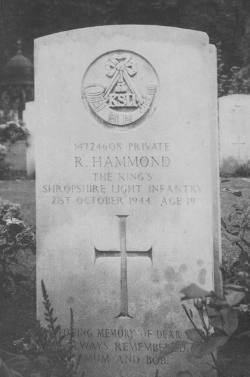
- Headstone at Brussels Town Cemetery, Belgium
|
From notes
provided by Albert T Cole dated 18th March 2008. |
-

- Private
7360478 Alfred Ronald D Whapshott
- Royal Army Medical Corps.
| Alfred R D Whapshott, who died age 25, was killed
by a mortar shell during some very difficult fighting high in the mountains
of Italy on Wednesday 29 November 1944 and is buried in the Faenza War
Cemetery, Italy. This cemetery was formed in the winter of 1944 for the
burial of 1,152 Commonwealth troops killed in the static fighting before
the Allied advance was renewed in April 1945. |
- Known more fondly as "Ron" to his family
and friends he was husband to Doris Beryl (nee Fry) and the son of Albert
and Mary Rose Whapshott. Regrettably, his name on the War Memorial and
on the Roll of Honour is spelt incorrectly as "Wapshot". Ron,
born the 24th April 1919, lived with his parents at Fairlawn, Westwood
Lane, Normandy, working locally at Manor Fruit Farm. On the 1st November
1939 he enlisted for the Territorial Army at Maidstone, Kent for four years
with the colours and was subsequently drafted to Bridport in Dorset. As
a member of the Royal Army Medical Corps he was attached to The Queen's
Own Royal West Kent Regiment formed in 1881 from the 50th of Foot and the
97th of Foot that became respectively, the 1st and 2nd Battalion of the
newly formed Regiment.
|
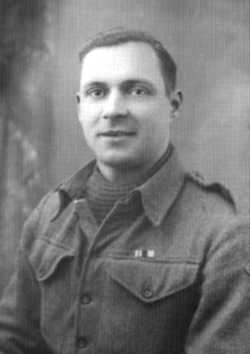
- Alfred Ronald Whapshott, 1944
|
| His military career led him to France and the
evacuation of Dunkirk, returning to these shores via Ramsgate in a coal
barge. Ron and Doris were married at St John the Baptist church, Puttenham
on the 10th August 1940, taking residence with his in-laws at 1 Yew Tree
Cottages, Weybourne Lane Farnham, but not for long. In 1941 he went overseas
to North Africa as part of the Eighth Army then to Sicily and finally to
Italy. He was awarded the Africa Star in June 1944 and later added the
Eighth Army Clasp in October of the same year. |
| On the 27th December 1944, Lt Colonel H V D
Iles RAMC at 132 Field Ambulance CMF, wrote to Doris:
"On the 29th November at about 10.30am, the stretcher bearers had
finished their nights work and were lying down resting when the mortar
shell exploded tight outside the door of the house they were in. Your husband
received a wound which was instantly fatal and five others were badly wounded,
one of them dying the next day."
Doris later re-married and had a very happy
marriage until 1989 when for a second time she was made a widow and she
now lives quietly in Fleet, Hampshire. |
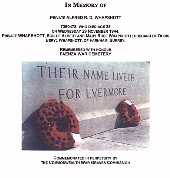
- Commemorative Certificate
- Click on photo to see an enlargement
|
-

-

 Back to Index Back to Index
-
- © Copyright by Normandy Historians
All Rights Reserved.
|





















